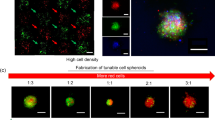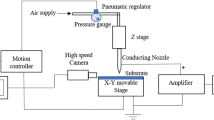Abstract
Ink-jet printing is a non-impact printing technology in which drops jetted from an orifice onto a designated position. This technology can digitally transport fluids containing cells precisely onto desired substrates to construct three-dimensional organs. In order to obtain the stable uniform droplets, a stream is the key point of this technology. However, there are so many factors that affect the uniform droplet stream construction process: print parameters, material parameters, control method, etc. A good understanding of the various coupled transport processes that occur during bio-ink impact and spreading on bio-structure can improve the success of print-ability. This paper aims to obtain a good linear bio-structure with ink-jet printing technology. First, a typical droplet deposition process model is constructed; including droplet dynamics impact models and droplet diffusion cap models. Second, a model of successive droplet overlap, to form linear bio-structures, is constructed. Third, the finite element method is used to simulate the droplet impact, collision, and fusion process. Finally, the main influencing factors of the continuous injection printing process, namely the time interval between consecutive droplets and the droplet contact angles, are discussed. Sodium alginate is selected as bio-ink to verify the theory, and it is found that a good linear bio-structure could be obtained if the printing parameters are controlled optimally, i.e., if the initial contact angle is set as 60 degrees and the trigger frequency is set as 150 kHz. With a proper printing speed and gel coating, a good survival rate of printed cells could be obtained.
















Similar content being viewed by others
Abbreviations
- \(R_{\text{droplet}}\) :
-
The radius of the initial droplet
- \(R\) :
-
The droplet spreading radius
- \(r\) :
-
The radius of the gap
- \(h\) :
-
The height of the cap
- \(\theta\) :
-
The contact angle
- \(\theta_{\text{a}}\) :
-
The contact angle when spreading to the maximum area
- \(U_{0}\) :
-
The dropping speed
- \(D_{0}\) :
-
The diameter of the droplet
- \(\rho\) :
-
The density of fluid
- \(\sigma\) :
-
The surface tension
- \(E_{{{\text{K}}1}}\) :
-
The kinetic energy
- \(E_{{{\text{S}}1}}\) :
-
The surface energy of the droplet
- \(E_{{{\text{S}}2}}\) :
-
The surface energy of droplets falling on the substrate and spreading to the maximum area
- \(W\) :
-
The viscous dissipated energy
- \(t_{c}\) :
-
The spreading time
- \(\varOmega\) :
-
The volume of viscous fluid
- \(\varphi\) :
-
The dissipation function
- \(\delta\) :
-
The thickness of the spreading boundary layer
- \(R{\text{e}}\) :
-
The Reynolds number of fluid
- \(U_{R}\) :
-
The droplet spreading speed
- \(d\) :
-
The spreading diameter of the base plate when the droplet impacts
- D :
-
The diameter of the wetted surface area
- H :
-
The thickness of liquid when spreading to maximum diameter
- \(\beta\) :
-
The original spread factor computation formula
- \(\beta_{\text{new}}\) :
-
The new spread factor computation formula
- \(v\) :
-
The nozzle moving speed
- \(f\) :
-
The transmission frequency
- \(\Delta x\) :
-
The center distance between the prints
- \(L\) :
-
The length of linear bio-structure
- \(N\) :
-
The droplet number of printed
- \(r_{\text{e}}\) :
-
The equilibrium wetting radius
- \(U\) :
-
The moving speed of the base plate
- \(W_{f}\) :
-
The maximum width of linear bio-structure
References
Murphy SV, Atala A (2014) 3D bioprinting of tissues and organs. Nat Biotechnol 32(8):773–785
Hölzl K, Lin S, Tytgat L, Vlierberghe SV, Ovsianikov A (2016) Bioink properties before, during and after 3D bioprinting. Biofabrication 8(3):032002
Jin Y, He Y, Gao Q et al (2014) Droplet deviation modeling and compensation scheme of inkjet printing [J]. Int J Adv Manuf Technol 75(9):1405–1415
Zhang M, Krishnamoorthy S, Song H et al (2017) Ligament flow during drop-on-demand inkjet printing of bioink containing living cells. J Appl Phys 121:124904
Xu C et al (2012) Scaffold-free inkjet printing of three-dimensional zigzag cellular tubes. Biotechnol Bioeng 109:3152–3160
Gong Y, Lv Y, Su S et al (2016) The predictive compensation path research of the micro tube fabrication process. Microsyst Technol 22:2209–2222
Lunkad SF, Buwa VV, Nigam KDP (2007) Numerical simulations of drop impact and spreading on horizontal and inclined surfaces [J]. Chem Eng Sci 62(24):7214–7224
Duineveld PC (2003) The stability of ink-jet printed lines of liquid with zero receding contact angle on a homogeneous substrate. J Fluid Mech 477:175–200
Pasandideh-Fard M, Chen P, Mostaghimi J et al (1996) The generalized Laplace equation of capillarity I. Thermodynamic and hydrostatic considerations of the fundamental equation for interface. Adv Colloid Interface Sci 63:151–177
Sikalo S, Tropea C, Ganic EN (2005) Dynamic wetting angle of a spreading droplet. Exp Therm Fluid Sci 29:795–802
Sikalo S, Ganic EN (2006) Phenomena of droplet-surface interactions. Exp Therm Fluid Sci 31:97–110
Roux DCD, Cooper-White JJ (2004) Dynamics of water spreading on a glass surface. J Colloid Interface Sci 277:424–436
Bennett T, Poulikakos D (1993) Splat-quench solidification: estimating the maximum spreading of a droplet impacting a solid surface. J Mater Sci 28:963–970
Chandra S, Avedisian CT (1991) On the collision of a droplet with a solid surface. In: Proceedings of mathematical and physical sciences, vol 6, pp 13–14
Vafaei S, Podowski MZ (2005) Analysis of the relationship between liquid droplet size and contact angle. Adv Colloid Interface Sci 113:133–146
Vafaei S, Podowski MZ (2005) Theoretical analysis on the effect of liquid droplet geometry on contact angle. Nucl Eng Des 235:1293–1301
Eggers J, Fontelos MA, Josserand C et al (2010) Drop dynamics after impact on a solid wall: theory and simulations. Phys Fluids 22:062101
Bakshi S, Roisman IV, Tropea C (2007) Investigations on the impact of a drop onto a small spherical target. Phys Fluids 19:032102
Shenglin Q, Shuang L, Weizhong L et al (2009) A simulation of impact of droplets on solid surfaces by using the lattice Boltzmann method. Chin J Comput Mech 26:627–632
Zeng X, Yang F, Qi L et al (2007) Simulation of the shape and flow field of a droplet after impacting a substrate. J Northwest Polytech Univ 25:528–532
Xu C, Zhang M, Huang Y et al (2014) Study of droplet formation process during drop-on-demand inkjetting of living cell-laden bioink [J]. Langmuir 30(30):9130–9138
Reis N, Ainsley C, Derby B (2005) Ink-jet delivery of particle suspensions by piezoelectric droplet ejectors. J Appl Phys 97(9):815
Gao Q, He Y, Fu J et al (2015) Fabrication of shape controllable alginate microparticles based on drop-on-demand jetting [J]. J Sol-Gel Sci Technol 77(3):610–619
Funding
The work is financially supported by the National Natural Science Foundation of China (51805475, 51675148)
Author information
Authors and Affiliations
Contributions
Conceptualization, Youping Gong and Xiangjuan Bian; Data curation, Zhikai Bi, Jingyang He, and Guojin Chen; Formal analysis, Youping Gong, Xiangjuan Bian and Xiang Zhang; Funding acquisition, Youping Gong, Huifeng Shao and Guojin Chen; Investigation, Jingyang He; Methodology, Youping Gong, Xiangjuan Bian; Project administration, Youping Gong; Resources, Anlei Ge; Software, Youping Gong, Zhikai Bi, Wenxin Li and Jingang He; Supervision, Youping Gong; Validation, Xiangjuan Bian; Writing – original draft, Youping Gong, Zhikai Bi, Xiangjuan Bian and Anlei Ge; Writing – review & editing, Xiangjiuan Bian.
Corresponding author
Ethics declarations
Conflict of interest
The authors declare no conflicts of interest.
Ethical approval
This study does not contain any studies with human or animal subjects performed any of the authors.
Rights and permissions
About this article
Cite this article
Gong, Y., Bi, Z., Bian, X. et al. Study on linear bio-structure print process based on alginate bio-ink in 3D bio-fabrication. Bio-des. Manuf. 3, 109–121 (2020). https://doi.org/10.1007/s42242-020-00065-9
Received:
Accepted:
Published:
Issue Date:
DOI: https://doi.org/10.1007/s42242-020-00065-9




